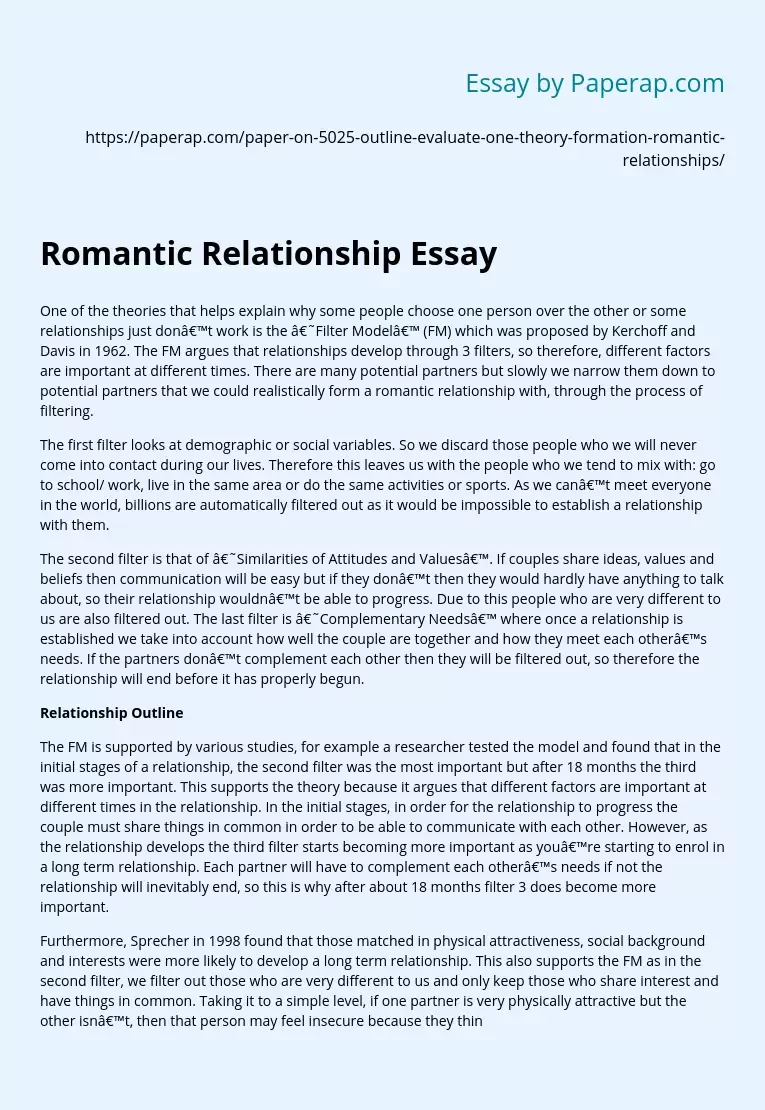Romantic Relationship Essay
One of the theories that help explain why some people choose one person over the other or some relationships just don’t work is the ‘Filter Model’ (FM) which was proposed by Kerchoff and Davis in 1962. The FM argues that relationships develop through 3 filters, so, therefore, different factors are important at different times. There are many potential partners but slowly we narrow them down to potential partners that we could realistically form a romantic relationship with, through the process of filtering.
The first filter looks at demographic or social variables. So we discard those people with who we will never come into contact during our lives. Therefore this leaves us with the people who we tend to mix with: go to school/ work, live in the same area or do the same activities or sports. As we can’t meet everyone in the world, billions are automatically filtered out as it would be impossible to establish a relationship with them.
The second filter is that of ‘Similarities of Attitudes and Values’.
If couples share ideas, values and beliefs then communication will be easy but if they don’t then they would hardly have anything to talk about, so their relationship wouldn’t be able to progress. Due to this people who are very different from us are also filtered out. The last filter is ‘Complementary Needs’ where once a relationship is established we take into account how well the couple is together and how they meet each other’s needs. If the partners don’t complement each other then they will be filtered out, so therefore the relationship will end before it has properly begun.
The FM is supported by various studies, for example, a researcher tested the model and found that in the initial stages of a relationship, the second filter was the most important but after 18 months the third was more important. This supports the theory because it argues that different factors are important at different times in the relationship. In the initial stages, in order for the relationship to progress, the couple must share things in common in order to be able to communicate with each other. However, as the relationship develops the third filter starts becoming more important as you’re starting to enroll in a long-term relationship. Each partner will have to complement each other’s needs if not the relationship will inevitably end, so this is why after about 18 months filter 3 does become more important.
Furthermore, Sprecher in 1998 found that those matched in physical attractiveness, social background, and interests were more likely to develop a long-term relationship. This also supports the FM as in the second filter, we filter out those who are very different from us and only keep those who share interests and have things in common. Taking it to a simple level, if one partner is very physically attractive but the other isn’t, then that person may feel insecure because they think that their partner should be with someone of their ‘standards’. Also, if there is nothing or very little in common then communication will be very difficult, thus leading to the end of the relationship.
There are some issues with the methodology used when testing the FM. Firstly it was a longitudinal study so it could be subject to attrition. As participants had the right to withdraw, then those who felt they were inadequate in the study would have dropped out, leaving those who are better in relationships, maybe for reasons such as they are securely attached. This would have led to the results obtained being biased as the sample wouldn’t have been representative.
In conjunction with this, questionnaires were used. As it was an opportunity sample the students may have responded in a way that they thought would benefit the researcher and in a way that was regarded by social norms. Therefore all these factors show that there was social desirability bias, demand characteristics, and population validity. There is another type of bias; social-economic bias, as student couples of the same age group and culture were used. This is further reinforced as only one generation was used. If a few generations would have been used then there may have been another trend in the results, for example, older generations would have found filter 2 more important than filter 3.
By explaining relationship formation in stages it fails to capture their fluid and dynamic nature. Some relationships flow at a slower or faster rate than the model suggests. It may not take a couple of 18 months for the third filter to become most important and the evidence suggests. Alongside to this, the FM doesn’t account for individual differences as it has only dealt with similarities of personality and attitudes. There are some couples who have nothing in common but their relationship is as strong as others who have everything in common. Sometimes it’s better to have fewer things in common than everything because couples can get bored of each other when everything they do is the same.
Romantic Relationship Essay. (2019, Dec 05). Retrieved from https://paperap.com/paper-on-5025-outline-evaluate-one-theory-formation-romantic-relationships/

